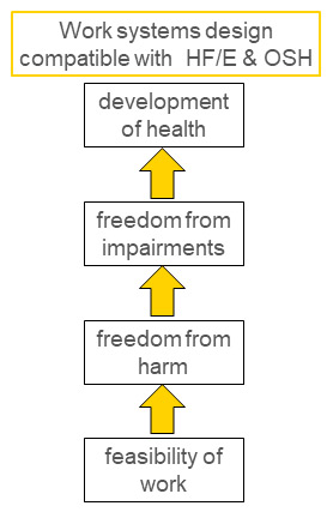The Criteria of Work System Design
Design in human factors and ergonomics (HF&E) traditionally aims at fulfilling high-level criteria as illustrated below. The work system as a whole, all components and their interactions shall be designed to fulfil the criteria at a high level in hierarchy. The criteria cover those relevant in human centred design of working conditions and have a strong impact in OSH. Design requirements and recommendations as introduced under Work Behaviour Issues, Work Place Issues and Work Equipment Issues contribute to the criteria presented below and the level in criteria hierarchy.
Design shall enable
- feasibility of work compatible with generic human physical and mental abilities (e.g. hand grip and force, colour discrimination),
- freedom from harm by OSH classics (e.g. obstacle-free floor for trip reduction),
- freedom from physical and mental impairment through task variations (e.g. limited monitoring time to avoid low vigilance), and
- development of learning, health and personality (e.g. to improve general competences, capacities and experiences)

Feasibility of work is the basic criterion and requires consideration of generic human abilities in the process of designing work systems. It addresses human physical and mental capabilities, limitations and needs across the working life.
Freedom from harm goes beyond the latter criterion and specifically calls for prevention of occupational accidents and diseases as well as work-related health risks by design of safe and healthy working conditions. Even though work could be feasible according to human abilities and capabilities, due to safety and health risks it may not be free of harm. Design should be adapted accordingly.
Freedom from physical and mental impairments avoids working conditions that impair human activities and conscious experience potentially resulting in accidents. Impairments such as mental fatigue, mental satiation, monotony and reduced vigilance result in deteriorations of human performance capabilities that may also manifest in harm when occurring frequently or over longer periods.
Development of learning, health and personality is strongly influenced by work and working conditions. While previous criteria intent to protect workers against risks this top-level criterion is prospective, aims at well-being and calls for a sustainable perspective on a broad range of factors in work systems design including inter-individual interactions and work-life balance.
Strategies to achieve higher levels across the four criteria refer to HF&E knowledge available in terms of design requirements and recommendations or empirical investigations on effects of physical and mental workload. Work system design compatible with HF&E design strategies and principles such as task orientation and compatibility results in optimal levels of workload. Deviations from optimal levels may cause shifts in well-being, facilitating or impairing effects or safety and health risks. Suitable requirements and recommendations for work system design according to HF&E as well as OSH should therefore be accessible to all.
References:
- EN ISO 6385. Ergonomic principles in the design of work systems.
- ISO 45001. Occupational health and safety management systems - Requirements with guidance for use.
- Hacker, W. (2011). Mental Workload. In: J.M. Stellmann (ed.), ILO Encyclopaedia of Occupational Health and Safety (vol. 1, 29.41-43). Geneva: International Labour Office.
- Lee, J.D., Wickens, C.D., Liu, Y. & Ng Boyle, L. (2017). Designing for People: An Introduction to Human Factors Engineering. Charlston: CreateSpace.
- Ulich, E., Schüpbach, H., Schilling, A. & Kuark, J. (1990). Concepts and procedures of work psychology for the analysis, evaluation and design of advanced manufacturing systems: A case study. International Journal of Industrial Ergonomics 5(1), 47-57.

